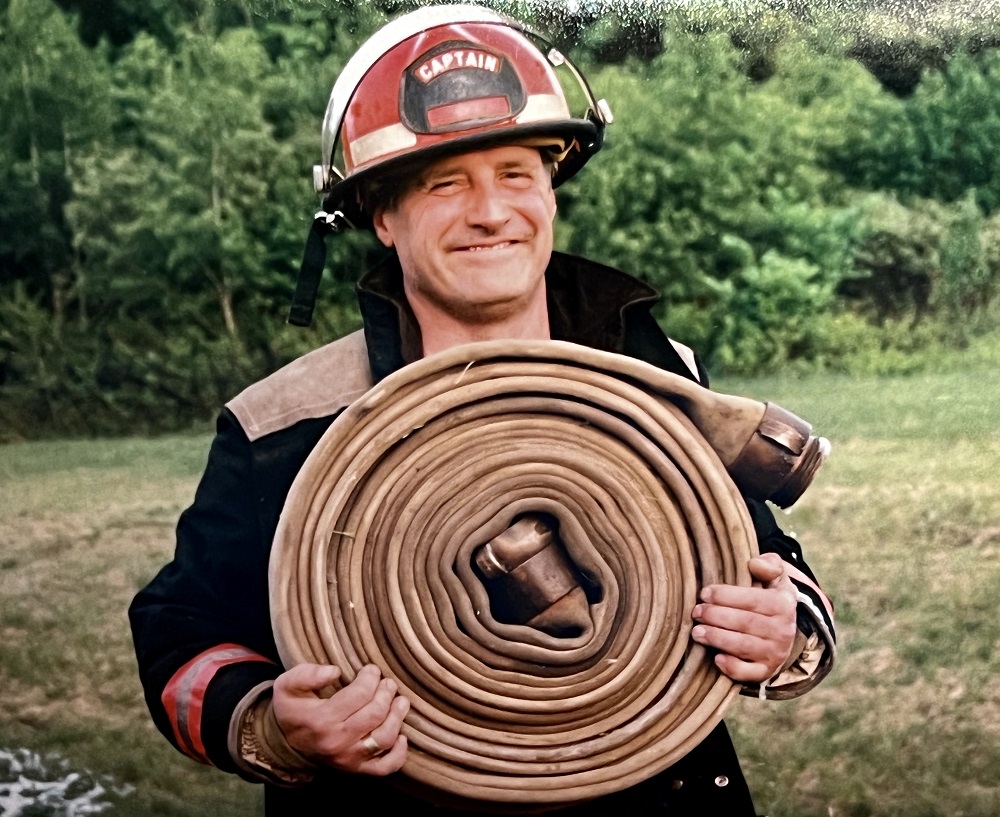Even before joining the Oakville Fire Department, Tony Aymong stopped for roadside accidents. “Hardwired to help,” he is into 50-plus years with emergency services.
It all began in 1972 when 22-year-old Aymong saw an ad in an Oakville newspaper looking for firefighters. He applied and got the job.
A self-described “hands-on person,” he said it was exciting. The fire department quickly recognized his jack-of-all trades ability and one of his first jobs was helping to repaint a truck. Then they asked him to retrofit a door from a cement block wall. “Ninety-five per cent of your work at the fire hall is cleaning and preparing for the five per cent of calls,” he noted.
His schedule involved working four nights, followed by seven days off, so it afforded him time to come up to the family cottage on Boshkung Lake.
He recalls his first fatality, with the alarm going off at 5 a.m. one morning before heading north. They responded to an accident on the QEW. A three-ton cucumber truck going to market in Toronto was involved and the husband and wife killed.
He worked with Oakville for a couple of years, but said his real dream was to become a police officer. He realized that goal in joining the former Mississauga police department. That career lasted 18 months as the call of the County brought him back permanently to the cottage despite still working in the city for many years.
“I love Haliburton County,” he said.
He got an electrical apprenticeship with Yake Electric and joined the volunteer fire department in Minden because his journeyman was a captain there.
When the Toronto Fire Department put out a call for career firefighters, Aymong applied, was hired, and spent the next 25 years working all over the city, including on the William Lyon Mackenzie fireboat and Toronto Island.
His first big fire was during the first week of drill school when the Eaton’s Annex building, at Albert and James streets, caught fire. The fire was so big that the recruits were pulled out of class and sent to help. Aymong said he was “excited” as several vans transported the rookies to the fire.
A couple of years into that career he stopped at a structure fire at Hwy. 118 and Hewitt Road near Carnarvon. George Wilson was the Stanhope Fire Department chief and when Aymong asked if they needed a hand, Wilson said ‘yes’.
“Someone threw me a petch coat and that was the beginning of being on the Stanhope fire department.” He’s still there more than 40 years later, noting that when he moved up permanently, he was asked to join various service clubs, but chose to dedicate his time exclusively to the fire service.
“John Hogg and I went into that building … the phone had melted, the fan had melted. We knocked the fire down really fast, and my air alarm went off. I ran out, changed bottles and ran back in.”
By that time, Aymong was a career and volunteer firefighter, known as a two-hatter; and he had purchased Yake Electric, which he ran for 25 years. At Stanhope, he was a captain for many years and then deputy chief. However, being a paper pusher was not his thing, so he happily stepped back to being a firefighter.
He’s glad he joined Stanhope, saying, “I think I’ve been a benefit to the community.”
At 72, he is transitioning from the front lines to more of a supporting role. He still responds to calls, but is more likely to ferry air bottles than enter a burning building. He’s also the guy the chief asks to take the fire department boat in for servicing, make minor repairs and annually organizes the hose testing. “There’s a role for everyone, at any age,” he says.
Aymong said there’s a big difference between urban and rural firefighting. In Toronto, they’d respond to an accident, help paramedics and go back to the station for a coffee. He said they never heard about it again, except maybe a snippet on the TV news.
By contrast, he said volunteer firefighters are often called to the homes of friends, family and neighbours, which can be tough. His first experience was going to someone with chest pain to find an elderly neighbour whom he comforted until the ambulance came. The next week, he attended the same man’s funeral. That was the first of many such experiences.
Asked what he would tell would-be firefighters, Aymong said, “it’s a great job. It’s also good money. You can go from volunteer to career firefighter.” And many career firefighters continue to volunteer once they’re on a bigger department.
But for him, it all comes back to that helper mentality.
“It’s been great to serve the community all these years.”





